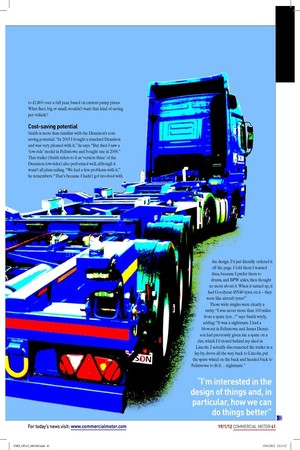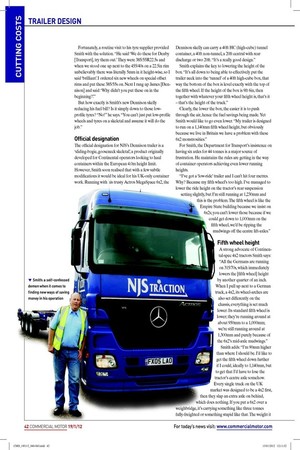TRAILER DESIGN
Page 33

Page 34

Page 35

Page 36

If you've noticed an error in this article please click here to report it so we can fix it.
FINDING WAYS TO CUT COSTS
Modified Dennison skelly saves a packet on fuel
Keep your head down
Words: Brian Weatherley
For owner-driver Nick Smith a firm focus on detail and a close-working relationship with trailer maker Dennison is paying off at the fuel pumps
Ask any operator about reducing costs
and they’ll tell you the devil is always in the detail. And when it comes to attention to detail, owner-driver Nick Smith is a self-confessed demon for inding new ways to save money. “I’m interested in the design of things and in particular how we can do things better,” he says. It certainly explains why he’s spent so much time ensuring his latest Dennison skeletal trailer is optimised for proitability – not a bad approach in an industry sector notorious for ‘competitive rates’ .
As with most hauliers, diesel is far and away NJS Traction’s biggest single expense and with the price rising inexorably, saving fuel has never been more important. During a lengthy conversation with Smith, CM is impressed to learn that his six-year-old Mercedes-Benz Actros 2546 is delivering an extra quarter-of-a-mile to the gallon since it was hitched to his new Dennison skelly. While this might seem a modest saving (Smith insists it’s still early days), based on his annual mileage and meticulous measuring, he’s on track to save up to £1,800 over a full year, based on current pump prices. What leet, big or small, wouldn’t want that kind of saving per vehicle?
Cost-saving potential
Smith is more than familiar with the Dennison’s costsaving potential. “In 2003 I bought a standard Dennison and was very pleased with it,” he says. “But then I saw a ‘low-ride’ model in Felixstowe and bought one in 2006.” That trailer (Smith refers to it as ‘version three’ of the Dennison low-rider) also performed well, although it wasn’t all plain sailing. “We had a few problems with it,” he remembers. “That’s because I hadn’t got involved with the design. I’d just literally ordered it off the page. I told them I wanted discs, because I prefer them to drums, and BPW axles, then thought no more about it. When it turned up, it had Goodyear 455/40 tyres on it – they were like aircraft tyres!” Those wide singles were clearly a rarity. “I was never more than 100 miles from a spare tyre...!” says Smith wryly, adding: “It was a nightmare. I had a blowout in Felixstowe and James Dennison had previously given me a spare on a rim, which I’d stored behind my shed in Lincoln. I actually disconnected the trailer in a lay-by, drove all the way back to Lincoln, put the spare wheel on the back and headed back to Felixstowe to it it... nightmare.” Fortunately, a routine visit to his tyre supplier provided Smith with the solution. “He said ‘We do these for Denby [Transport], try them out.’ They were 385/55R22.5s and when we stood one up next to the 455/40s on a 22.5in rim unbelievably there was literally 5mm in it height-wise, so I said ‘brilliant’. I ordered six new wheels on special offset rims and put these 385/55s on. Next I rang up James [Dennison] and said: ‘Why didn’t you put these on in the beginning?’.” But how exactly is Smith’s new Dennison skelly reducing his fuel bill? Is it simply down to those lowproile tyres? “No!” he says. “You can’t just put low-proile wheels and tyres on a skeletal and assume it will do the job.”
Official designation
The oficial designation for NJS’s Dennison trailer is a ‘sliding-bogie, gooseneck skeletal’, a product originally developed for Continental operators looking to haul containers within the European 4.0m height limit. However, Smith soon realised that with a few subtle modiications it would be ideal for his UK-only container work. Running with his trusty Actros MegaSpace 6x2, the Dennison skelly can carry a 40ft HC (high-cube) tunnel container, a 40ft non-tunnel, a 20ft central with rear discharge or two 20ft. “It’s a really good design.” Smith explains the key to lowering the height of the box. “It’s all down to being able to effectively put the trailer neck into the ‘tunnel’ of a 40ft high-cube box, that way the bottom of the box is level exactly with the top of the ifth wheel. If the height of the box is 9ft 6in, then together with whatever your ifth wheel height is, that’s it – that’s the height of the truck.” Clearly, the lower the box, the easier it is to push through the air, hence the fuel savings being made. Yet Smith would like to go even lower. “My trailer is designed to run on a 1,140mm ifth wheel height, but obviously because we live in Britain we have a problem with these 6x2 monstrosities.” For Smith, the Department for Transport’s insistence on having six axles for 44 tonnes is a major source of frustration. He maintains the rules are getting in the way of container operators achieving even lower running heights.
“I’ve got a ‘low-ride’ trailer and I can’t hit four metres. Why? Because my ifth wheel’s too high. I’ve managed to lower the ride height on the tractor’s rear suspension setting slightly, but I’m still running at 1,230mm and this is the problem. The ifth wheel is like the Empire State building because we insist on 6x2s; you can’t lower those because if we could get down to 1,000mm on the ifth wheel, we’d be ripping the mudwings off the centre lift-axles.”
Fifth wheel height
A strong advocate of Continental-spec 4x2 tractors Smith says: “All the Germans are running on 315/70s, which immediately lowers the [ifth wheel] height by another quarter of an inch. When I pull up next to a German truck, a 4x2, its wheel-arches are also set differently on the chassis, everything is set much lower. Its standard ifth wheel is lower; they’re running around at about 950mm to a 1,000mm; we’re still running around at 1,300mm and purely because of the 6x2’s mid-axle mudwings.” Smith adds: “I’m 90mm higher than where I should be. I’d like to get the ifth wheel down further if I could, ideally to 1,140mm, but to get that I’d have to lose the tractor’s centre axle somehow.
Every single truck on the UK market was designed to be a 4x2 irst, then they slap an extra axle on behind, which does nothing. If you put a 6x2 over a weighbridge, it’s carrying something like three tonnes fully-freighted or something stupid like that. The weight it [the middle axle] carries is negligible. My truck has done 900,000km and I’ve changed the front-steer and reardrive axle pads and discs twice in that time. The mid-axle has still got the original discs and pads, they’ve never worn out. They’ll go around the planet 80 million times because that axle is a complete waste of time.”
Wheelarch solution
One obvious solution for Smith would be to remove the centre section of the mid-lift axle’s wheelarch. “My understanding is that you can do it as long as you have got something above it,” he says, “but you have to carry those removable sections with you. If you’ve got a curtainsider trailer covering the top [of the wheels], then no problem, but VOSA may well turn around and say to you ‘where are they’? If you’ve got them on a mounting on the back of the cab, you can say ‘there they are’. But the problem is on a container trailer. It’s covered all the while I’ve got a 40ft box on the back, but if you’re carrying a 20ft box, then the mudwings need to go back again. Fortunately, 85% of the boxes I carry are 40ft high-cube or standard.” While exasperated at not being able to run any lower Smith’s Dennison trailer already allows him to get under bridges with a high-cube box that would defeat many others. “With a standard-spec skeletal Dennison with a high-cube box on it, the lowest bridge you could get under is 14ft 6in, but I can get under a 13ft 7in – probably 13ft 6in – but I put 13ft 7in on my height guard to ensure I’ve got a ‘tolerance’ . ” Thus, the low-height offers additional routeing lexibility as well as fuel savings.
To ensure maximum tractor/trailer compatibility when running with taller trailers, Smith also specced his Actros with the roof delector kit normally itted to the LS cab, rather than the smaller delector used on the [taller] MegaSpace, although he says: “The biggest problem now is I can’t get it any lower.” Meanwhile, in the never-ending quest to keep his head down he is already looking at his next tractor being a 6x2 Actros, but with the optional smaller (and lighter) 17.5in wheels on the centre axle.
“It looks interesting, as it could cure most of our problems if we had to go to 4.0m,” he says. ■
EC 4M HEIGHT PROPOSALS
The ongoing uncertainty about European Commission proposals for the UK to accept a 4.0m overall height limit is worrying a number of hauliers, not least Nick Smith. “If the European Commission pushes this through – and it can push just about anything it likes through, as there’s no ability for the British government to say no – then every single container trailer in the country will have to be changed. The problem is the lowest container trailer we’ve got is probably the Dennison I’ve got now, but I can’t get down to 4.0m because we’ve got 6x2s not 4x2s, and we can’t get the fifth wheel down to 950mm or 1,000mm. The only people who can do that are the Germans.”












































